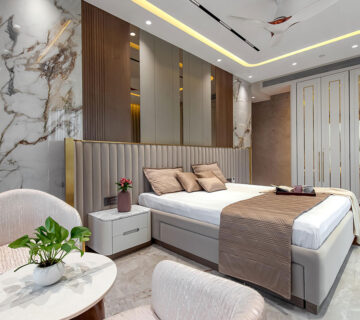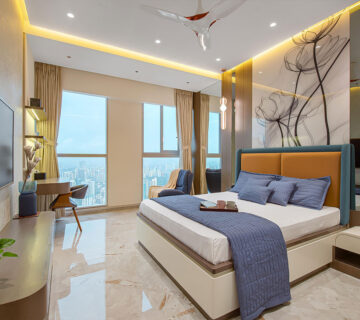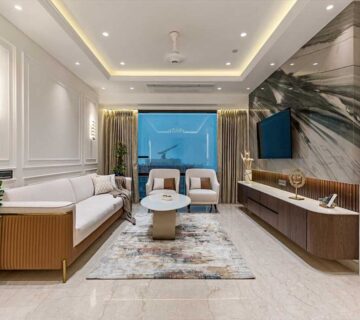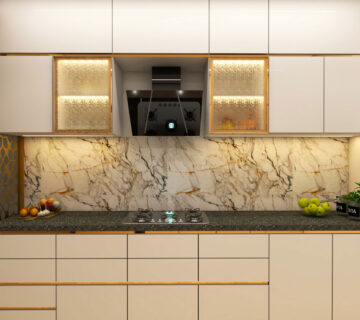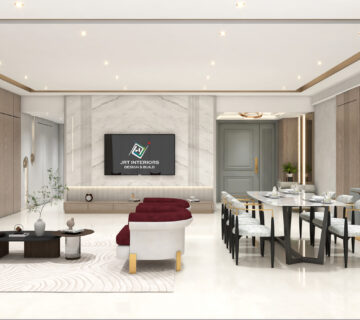In any interior design project, lighting is a crucial component. Interior designers recognize that lighting is integral in transforming a space from the outset of a project. No matter the overall budget for a project, well-executed and thoughtful lighting can transform an average interior into something spectacular.
Color and brightness play a key role in shaping how an individual feels in a particular place. Thus, lighting is a crucial aspect of interior design regardless of the investments made elsewhere. In addition to selecting attractive lampshades, it consists of three fundamental elements: ambient lighting, task lighting, and accent lighting. In the right hands, these elements can transform a space into an oasis of beauty.
Let’s have a look at three categories of lightning:
A) Ambient Lighting:
Often referred to as general lighting, ambient lighting illuminates a space uniformly throughout. Light sources that provide ambient lighting include recessed ceiling lights, track lights, wall lights, and cove lights.
B)Task Lighting:
The purpose of task lighting is to assist in performing specific tasks. An example of task lighting is under-cabinet lights in a kitchen, which are useful for activities such as cleaning and cutting. Other examples of task lights are desk lamps or the bedside reading lamps.
C) Accent Lighting:
Lighting accents are used to highlight specific areas or objects while simultaneously adding character to the overall interior lighting. Objects of interest, such as paintings or exquisite artifacts, are frequently highlighted with accent lighting.
Does lightning affect the mood?
Lighting affects mood and productivity in both residential and commercial spaces. A home’s lighting design should create a warm, welcoming, productive, flexible, and cheerful atmosphere. Alternatively, an office environment should be conducive to productivity, focus, and energy. Lighting design is vital to home renovations, influencing the perception of space, creating ambience, and, most importantly, shaping mood.
Which lightning to use?
Lightning for home
There are many interesting lighting options available for homes. Interior designers for home use soft, diffused light from the beginning of the design process since it offers maximum flexibility and results. Adding cove lights or hidden lights to a room will create a cozy glow without using large lighting fixtures. You may be able to achieve the desired soft lighting in a room using sconce lights or up-lighters if a complete interior design is not possible. Another way to provide even lighting and make all areas easier to see is with recessed lights. A floor lamp can also be used along with other soft lights to create a cozy atmosphere in a room. Adding accent lights to a room can add character and let you display things like paintings or collectables. Lighting accents, such as spotlights, focus light on a particular area or item.
Lightning for Office
Lighting in offices is primarily intended to improve productivity. It is important to have both general lighting (ambient) and focused lighting (task) in place. Panel lights are useful for general lighting. In a modular ceiling, they fit neatly, spreading light evenly. Furthermore, suspended lights are cool since they shine light downwards for tasks and upwards for a nice overall glow. The goal is to make the workspace as bright and efficient as possible!
Things to Consider Before Installing the Lights
Color
Light color, or Kelvin, plays a big role in the way a place feels. A lower Kelvin value means warmer light; a higher Kelvin value means cooler light. Choose lights with a lower Kelvin if you want a cozy atmosphere. Choose lights with a higher Kelvin to create a bright, well-lit atmosphere. The best interior designers usually choose lighting with a lower Kelvin for homes. In offices, higher Kelvin lights are best. In some cases, designers might mix light colors based on the goal of the design.
Light Distribution
In terms of lighting, it’s not just about brightness. It is also important for interior designers to spread the light evenly. Ensure there are no dark spots or shadows between spaces and that areas connecting them are well-lit.
Intensity of the Light
Light intensity is just as important as its color. The intensity of the light must match the area you wish to illuminate. The space will feel unwelcoming if there is too much light. The room will look gloomy and unwelcoming if there is too little light.
Conclusion
The lighting is as important as any other aspect of the design. An effective lighting system has the power to alter and enhance a space. The lighting in the room does more than make one feel cozy; it also adds a touch of drama and atmosphere.



